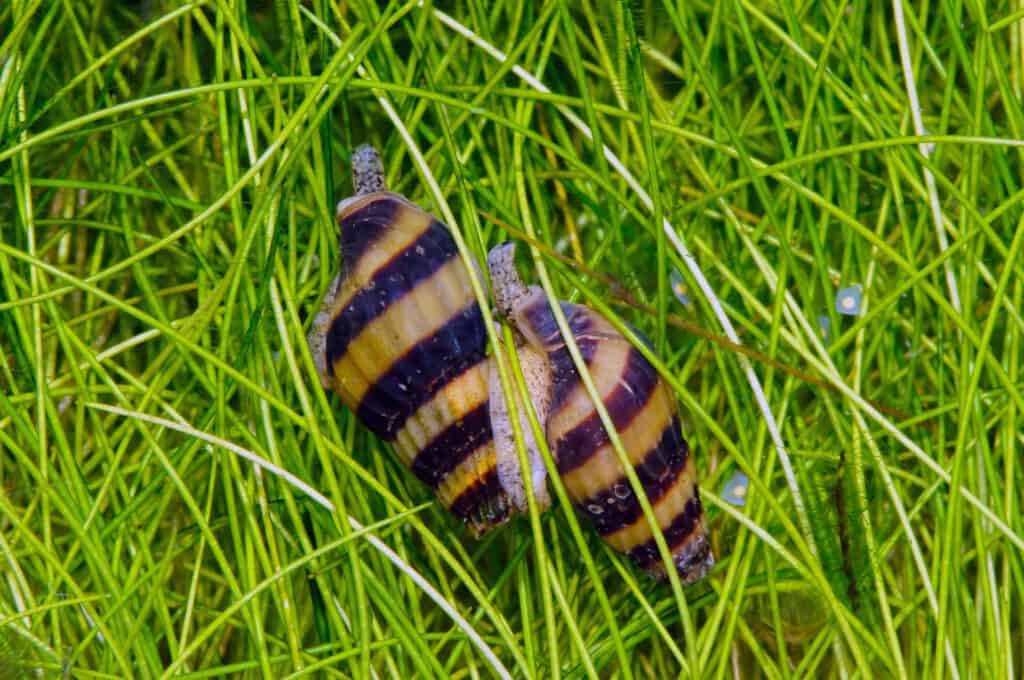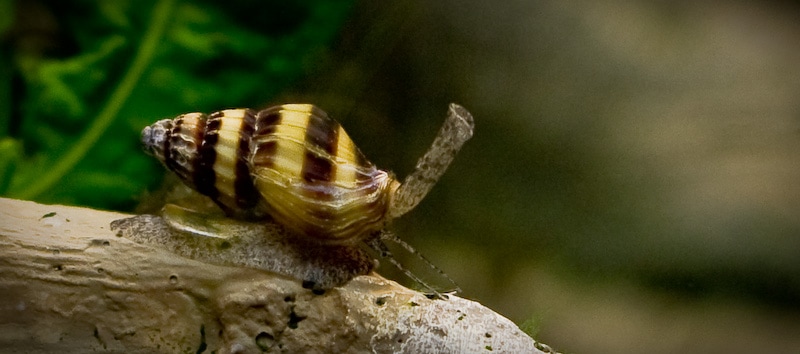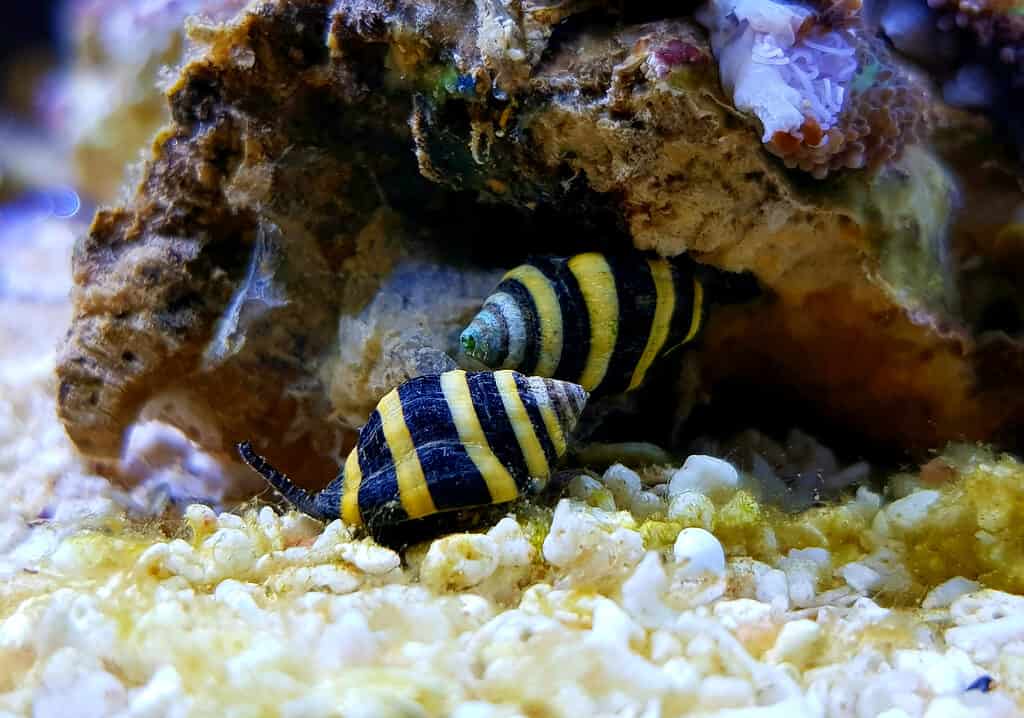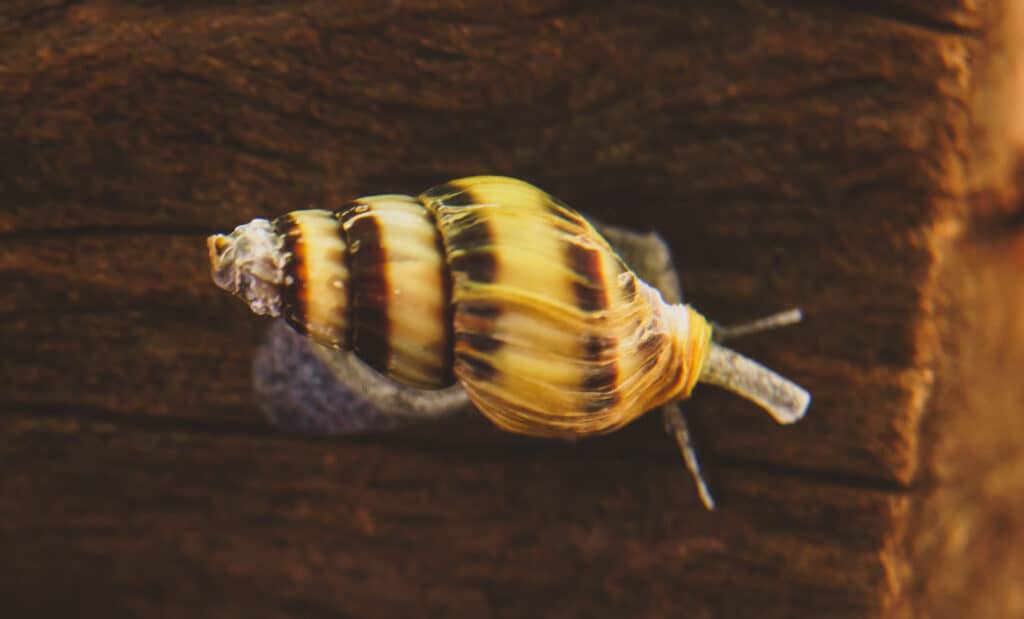Assassin Snail
Clea helena
Assassin snails attack and eat other snails.
Advertisement
Assassin Snail Scientific Classification
- Kingdom
- Animalia
- Phylum
- Mollusca
- Class
- Gastropoda
- Order
- Neogastropoda
- Family
- Nassariidae
- Genus
- Clea
- Scientific Name
- Clea helena
Read our Complete Guide to Classification of Animals.
Assassin Snail Conservation Status
Assassin Snail Facts
- Prey
- snails and worms
- Main Prey
- snails
- Group Behavior
- Sociable
- Solitary/Group
- Fun Fact
- Assassin snails attack and eat other snails.
- Biggest Threat
- predation, health problems such as parasitic infections
- Distinctive Feature
- brown and yellow striped shell
- Other Name(s)
- bumblebee snail
- Incubation Period
- three to eight weeks
- Habitat
- tropical freshwater like rivers, lakes, reservoirs, canals, streams, and aquariums
- Predators
- larger cichlids, and fish that eat snails such as loaches.
- Diet
- Carnivore
- Lifestyle
- Nocturnal
- Favorite Food
- snails
- Common Name
- assassin snail
- Special Features
- brown and yellow striped shell
- Origin
- Thailand, Malaysia, and Indonesia
- Location
- tropical freshwater bodies such as canals, streams, lakes, and rivers
- Slogan
- The snail-eating snail.
- Nesting Location
- any hard surface inside the water, on plants, on wood, or on the surface of aquarium tank
Assassin Snail Physical Characteristics
- Color
- Brown
- Yellow
- Dark Brown
- Multi-colored
- Lifespan
- two to five years
- Length
- 0.7 to 1.25 inches
- Age of Sexual Maturity
- about six months
- Venomous
- No
- Aggression
- Low
View all of the Assassin Snail images!
The name “assassin” is enough to strike fear into the hearts of all who hear it, but in reality, assassin snails are not scary at all. Assassin snails are highly sought after by owners of household marine habitats because of their predilection for snail meat. While they are the bane of other snail species everywhere, they get along quite swimmingly with each other and work together to take down bigger snails.
Quick Facts on the Assassin Snail
- Carnivore snails: Assassin snails are carnivores. They belong to a carnivorous order of snails and are also scavengers.
- Male and female: Assassin snails are not hermaphrodites like a lot of other types of snails. They have distinct male and female sexes. However, it is impossible to tell them apart because they look exactly the same. Breeding assassin snails involves leaving a bunch of them to go at it.
- The Terminator snails: Assassin snails eat other snails. Because of this, they are becoming popular for people whose aquariums have been infiltrated by pest snails that eat up all their plants.
- Ideal exterminator: What makes assassin snails the ideal exterminator for pest snails is that they don’t eat aquatic plants, and they are slow breeders so they don’t become pests themselves. They can be quite tasking to get rid of due to their burrowing habits.
- Bumblebees of the sea: Assassin snails are called bumblebee snails because of the color pattern of their shells. While some of them are solid brown, most of them have brown and yellow stripes, resembling a bumblebee.
- Teamwork makes the dream work: Assassin snails usually band together to take down larger prey. If your tank is riddled with a ton of pest snails, it is best to introduce enough assassins to get the job done because they are slow eaters.

Assassin snails are also called bumblebee snails because of the brown and yellow stripe color pattern of their shells.
©iStock.com/corridor91
Assassin Snail Scientific Name
Assassin snails are named after their predilection for other snails. They are often used to get rid of pest snails in aquariums. Assassin snails are freshwater snails that belong to the genus Clea, a group of freshwater snails that comprises of ten species. They also belong to the family Nassariidae, also known as Nassa mud snails or dog whelks, and is made up of sea snails and some marine mollusks.
The proper classification for the assassin snail is Clea helena, but a lot of authors prefer to use the original genus Anentome to classify the snail instead (Anentome helena). In order to differentiate between the African and Asian species, some zoologists named the Asian subgenus Anentome, and the African subgenus Afrocanidia. The genera Clea and Anentome are still used interchangeably.
Assassin snails are also likely to be called bumblebee snails because of their typical brown and yellow shell pattern.
Evolution and History
Assassin snails belong to the order Neogastropoda which is composed of about 16,000 species of gastropods, including mollusks, clams, oysters, sea and marine snails. The fossil record of Neogastropoda is considered almost completed and traces the evolutionary history of the order.
Neogastropoda is believed to have originated in the Early Cretaceous Epoch 145 million to 100.5 million years ago. They diversified twice during the late Cretaceous Period which lasted 100.5 million years to 66 million years ago and the Paleocene Period 66 million to 23.03 million years ago.
The members of Neogastropoda evolved to have shells with elongated siphonal canals and siphons that suck water into the mantle cavity. They also developed an advanced proboscis used to scrape out flesh remnants from inside the shells of their prey. During their evolutionary process, Neogastropoda species experienced another physiological change wherein the mouth moved to a terminal position on its head.
Assassin Snail Appearance
Assassin snails are tiny snails compared to the damage they can inflict on their snail prey. They grow to be 0.7 to 1.25 inches in size in the wild, but they tend to be smaller when raised in captivity. If given an insufficient amount of food, they will suffer from malnutrition and stunted growth. Also called bumblebee snails, the assassin snail has a conical shell with dark brown and yellow alternating stripes that resemble the hair on a bumblebee. Although their color pattern is a unique way of identifying them, not all assassin snails have this pattern. Some snails are just brown without the yellow stripes.
The assassin snail has a siphon, which is a long tube-like structure used to breathe, sense its surroundings and find prey. The snail also possesses a translucent, muscular foot, a pair of tentacles, as well as a proboscis which it uses to comb inside the shell of its prey for meat remnants.
Assassin snails have males and females, unlike a lot of other snail species who are hermaphroditic. However, the sexual dimorphism in assassins is nonexistent. There is no way to tell the males and females apart because they all look exactly alike.

The assassin snail has a siphon, which is a long tube-like structure used to breathe, sense its surroundings and find prey.
©RSX, CC BY-SA 3.0 <https://creativecommons.org/licenses/by-sa/3.0>, via Wikimedia Commons – License
Behavior
Bumblebee snails are usually inactive during the day. They are burrowing animals and spend most of their time buried in the substrate at the bottom of the aquarium. They come alive at night, hunting for their prey, which makes them nocturnal animals.
Assassin snails tend to be very sluggish in general, but mostly during the day. They are kept for their predatory nature toward other snails which is used to control and regulate the population of these snails in an aquarium. Assassin snails are not herbivorous animals and as such don’t have any interest in eating or uprooting plants. They are the perfect exterminators for people who have plant aquariums and invasive snail species who consume these plants.
Assassin snails don’t mind living the solitary life. However, if your aquarium has a lot of pest snails to get rid of, you might want to add more assassins to the mix. One assassin snail is not enough to control a large population of pest snails because they are such slow eaters. Also, a group of assassin snails has a better chance of taking down much larger snails.
Although the bumblebee snail is a carnivore, they don’t hurt live fish or larger invertebrates. They also don’t cannibalize themselves and actually get along quite well with each other.
Assassin snails usually stay burrowed at the bottom of tanks so if you notice your snails moving to the top of the tank, that might be a sign to clean it.

Although the bumblebee snail is a carnivore, they don’t hurt live fish or larger invertebrates and get along quite well with each other.
©Vojce/Shutterstock.com
Diet
Assassin snails are opportunistic carnivorous, a trait they share with all the other snails in the order Neogastropoda. They do not eat plants, but rather prefer to feed on other snails and worms alike. This trait of theirs is the reason why they are popular amongst pet owners who find invasive snails in their aquariums. Assassin snails will ambush snails bigger than themselves, often in a group if the snail is too large to be taken down by just one of them. This regulates the population of invasive snail species such as the Malaysian trumpet snail and the Ramshorn snails which harm aquatic plants.
Assassin snails ambush their prey in two ways. They bury themselves in the substrate at the bottom of the tank and patrol the environment with their siphon sticking out. When an unsuspecting snail moves by, the assassin detects and grabs it. The second way assassins hunt prey is simply by chasing them down.
Bumblebee snails don’t eat aquatic vegetation like the invasive snails do, so they are ideal for keeping in aquariums without worrying about plant destruction. They are also scavengers and eat decaying fish and other animals in their habitat.
Assassin snails have also been observed eating fish eggs. For owners who are fish breeders, this would pose a serious problem and it would be best to keep these snails as far away from the breeding tank as possible.
Bumblebee snails in captivity often do not need to be fed as long as there is a sufficient amount of snails in their habitat. If not, then their diet will need to be supplemented with food such as worms or any sinking food. The best time to feed these snails is at night when they are most active.
Habitat and Population of the Assassin Snail
Assassin snails are native to Southeastern Asian countries, namely, Thailand, Malaysia, and Indonesia. Their preferred habitats are tropical freshwater bodies such as canals, streams, lakes, and rivers. They are growing increasingly popular as pets due to the fact that they eat pest snails. They are introduced into aquariums to control the activity of pest snails that destroy the plants in the tank.
The assassin snail is not listed on the IUCN Red List of Threatened Species.

Assassin snails are carnivores often used to get rid of pest snails in aquariums.
©iStock.com/M-Production
Reproduction and Lifespan
Unlike many other snail species that reproduce asexually, assassin snails actually have separate male and female sexes. However, distinguishing between the sexes is impossible because of the lack of sexual dimorphism in the species. The males and females are the same size and shape.
The breeding behavior of Clea (Anentome) helena has been observed mostly in captivity. The mating snails lock on to one another and stay that way for about 12 hours. When they are done, the female will then lay several single, clear, square-shaped eggs. The eggs are usually laid on plants or any hard surface, even the tank glass.
The eggs hatch in about three to eight weeks, after which, the young snails will burrow into the substrate and stay there for about six months until they reach sexual maturity.
Because of its extensive breeding time, these snails seldom become pests themselves. Assassin snails typically live about two years in the wild but can live up to five years in captivity if they are handled properly.
Predators and Threats
Assassin snails are dedicated predators, but they get preyed on by larger carnivores, too. Their predators include larger cichlids, and fish that eat snails such as loaches. Although the snails have an operculum which acts as a trap door to protect the shelled creature, consistent attacks by snail-eating fish could injure the snail or even kill it.
Assassin snails also face various health problems, some of which are listed below.
- Parasitic Infection: Parasitic infections are the most common health problems that assassin snails face. They are susceptible to trematode parasites. This infection results in white spots on the snail’s shell and fatigue.
- Malnutrition: This occurs when there is a lack of adequate food in the snail’s living area. It mostly happens to assassin snails in captivity.
- Stunted growth: This can be as a result of malnutrition, as well as a lack of abundant living space.
- Brittle shell: This health issue can be caused by a calcium deficiency in the snail’s diet, or poor water conditions.
If you suspect your assassin snail might not be feeling too well, you can look out for some warning signs such as shell discoloration and inactivity.
Up Next
View all 194 animals that start with AAssassin Snail FAQs (Frequently Asked Questions)
Where do assassin snails come from originally?
Assassin snails are native to the Southeastern Asian countries Thailand, Malaysia, and Indonesia.
What do assassin snails eat?
Assassin snails are carnivorous predators and scavengers. They eat small invertebrates such as other snails, worms, and fish eggs. They also scavenge on dead animals like fish. These snails don’t go after live fish or larger invertebrates.
What eats assassin snails?
Their predators include larger cichlids, and fish that eat snails such as loaches.
Are assassin snails dangerous?
Despite their fear-inducing name, assassin snails aren’t dangerous to human beings. They are harmless creatures. They usually hide from human touch by recoiling into their shells. Too much handling could stress the snail out though, so it is best kept at a minimum and only when needed.
What kingdom do assassin snails belong to?
Assassin snails belong to the kingdom Animalia.
What phylum do assassin snails belong to?
Assassin snails belong to the phylum Mollusca.
What class do assassin snails belong to?
Assassin snails belong to the class Gastropoda.
What order do assassin snails belong to?
Assassin snails belong to the order Neogastropoda with other carnivorous gastropods.
What family do assassin snails belong to?
Assassin snails belong to the family Nassariidae.
What genus do Assassin snails belong to?
Assassin snails belong to the genus Clea and subgenus Anentome. Clea is made up of ten species of freshwater snails.
Thank you for reading! Have some feedback for us? Contact the AZ Animals editorial team.
Sources
- Aqua Info, Available here: https://aquainfo.org/anentome-helena-assassin-snail/
- Wikipedia, Available here: https://en.wikipedia.org/wiki/Anentome_helena
- Wikipedia, Available here: https://en.wikipedia.org/wiki/Anentome
- Wikipedia, Available here: https://en.wikipedia.org/wiki/Nassariidae
- Wikipedia, Available here: https://en.wikipedia.org/wiki/Neogastropoda
- PLOS Journals, Available here: https://journals.plos.org/plosone/article?id=10.1371/journal.pone.0264996

















